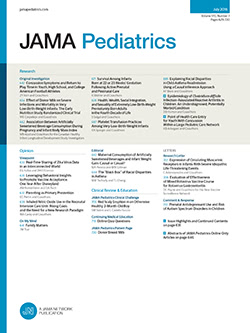mepolizumab治疗的城市儿童中残余哮喘加重的炎症途径:一项随机临床试验的二次分析。
IF 18
1区 医学
Q1 PEDIATRICS
引用次数: 0
摘要
虽然针对2型(T2)炎症的生物治疗降低了哮喘和T2炎症儿童的急性加重率,但仍会发生加重,其潜在的分子机制尚不明确。目的通过比较mepolizumab与安慰剂治疗的临床试验,确定城市嗜酸性哮喘儿童的呼吸系统疾病特征,从而确定与哮喘加重有关的多种不同分子机制。设计、环境和参与者:这是一项对免疫治疗预防和持续哮喘恶化机制的二级分析:一项系统方法2期(MUPPITS-2)双盲、安慰剂对照、平行组、随机临床试验,比较了美国9个城市低收入城市中心易加重哮喘儿童的美polizumab和安慰剂治疗。数据分析时间为2022年9月至2025年4月。干预措施参与者被随机分配接受mepolizumab(6-11岁:40mg;12-17岁:100毫克)或配合安慰剂皮下注射,每4周1次,连续52周。主要结果和测量方法主要测量方法是通过RNA测序对急性呼吸道疾病期间获得的鼻腔样本进行转录组模块化分析。研究了上呼吸道转录特征、呼吸系统疾病的临床结局和肺功能之间的关系。结果在290名参加MUPPITS-2试验的参与者中,108名参与者(中位[IQR]年龄,10.0[9.0-13.0]岁;在176例急性呼吸道疾病事件中抽取48例(44%)女性。在导致哮喘加重的疾病事件中,接受mepolizumab治疗的儿童表现出与T2炎症相关的嗜酸性粒细胞相关模块的表达降低(log2倍变化[FC]估计,-0.60;错误发现率[FDR] < 0.05),但与接受安慰剂的儿童相比,与上皮和巨噬细胞炎症途径相关的基因模块表达增加(log2 FC估计,0.22-0.85;fdr < 0.05)。两组在病情加重期间粘液分泌和细胞应激反应途径的表达均高于非病情加重。mepolizumab组在急性发作中表现出与呼吸道病毒无关的上皮炎症通路上调,而巨噬细胞通路特异性地促进了病毒急性发作。三个不同的,半正交的炎症轴被证明是两组恶化的异质性的基础。结论和相关性研究结果表明,与上皮细胞和巨噬细胞相关的多种炎症途径,以及粘液分泌过多,是接受mepolizumab治疗的儿童残留急性加重的机制。此外,它们表明多种不同的炎症轴可以独立地促进哮喘恶化。临床试验注册号:NCT03292588。本文章由计算机程序翻译,如有差异,请以英文原文为准。
Inflammatory Pathways in Residual Asthma Exacerbations Among Mepolizumab-Treated Urban Children: A Secondary Analysis of a Randomized Clinical Trial.
Importance
While biologic therapies targeting type 2 (T2) inflammation reduce acute exacerbation rates in children with asthma and T2 inflammation, exacerbations still occur, and the underlying molecular mechanisms are poorly defined.
Objective
To identify multiple distinct molecular mechanisms implicated in asthma exacerbations by characterizing respiratory illnesses among urban children with eosinophilic asthma enrolled in a clinical trial comparing treatment with mepolizumab vs placebo.
Design, Setting, and Participants
This is a secondary analysis of the Mechanisms Underlying Asthma Exacerbations Prevented and Persistent With Immune-Based Therapy: A Systems Approach Phase 2 (MUPPITS-2) double-blind, placebo-controlled, parallel-group, randomized clinical trial comparing treatment with mepolizumab vs placebo among children with exacerbation-prone asthma in low-income urban centers in 9 US cities. Data analysis was performed from September 2022 to April 2025.
Intervention
Participants were randomized to receive either mepolizumab (aged 6-11 years: 40 mg; aged 12-17 years: 100 mg) or matching placebo by subcutaneous injection once every 4 weeks for 52 weeks.
Main Outcomes and Measures
The primary measurement was a transcriptomic modular analysis by RNA sequencing of nasal samples obtained during acute respiratory illnesses. Associations among upper airway transcriptional signatures, the clinical outcome of respiratory illnesses, and pulmonary functions were investigated.
Results
Of the 290 participants enrolled in the MUPPITS-2 trial, 108 participants (median [IQR] age, 10.0 [9.0-13.0] years; 48 [44%] female) were sampled during 176 acute respiratory illness events. During illness events resulting in asthma exacerbations, children receiving mepolizumab demonstrated decreased expression of an eosinophil-associated module associated with T2 inflammation (log2 fold change [FC] estimate, -0.60; false discovery rate [FDR] < .05) but increased expression of gene modules associated with epithelial and macrophage inflammatory pathways relative to children receiving placebo (log2 FC estimates, 0.22-0.85; FDR < .05). Both groups showed higher expression of mucus secretion and cellular stress response pathways during exacerbations relative to nonexacerbation illnesses. The mepolizumab group demonstrated upregulation of epithelial inflammatory pathways in exacerbations irrespective of a respiratory virus, while macrophage pathways contributed specifically to viral exacerbations. Three distinct, semiorthogonal inflammatory axes were shown to underlie the majority of the heterogeneity among exacerbations in the 2 groups.
Conclusions and Relevance
The study's findings implicate multiple alternative inflammatory pathways associated with the epithelium and macrophages, as well as mucus hypersecretion, as mechanisms of residual acute exacerbations in children receiving mepolizumab. Further, they indicate that multiple distinct inflammatory axes can independently contribute to asthma exacerbations.
Trial Registration
ClinicalTrials.gov Identifier: NCT03292588.
求助全文
通过发布文献求助,成功后即可免费获取论文全文。
去求助
来源期刊

JAMA Pediatrics
PEDIATRICS-
CiteScore
31.60
自引率
1.90%
发文量
357
期刊介绍:
JAMA Pediatrics, the oldest continuously published pediatric journal in the US since 1911, is an international peer-reviewed publication and a part of the JAMA Network. Published weekly online and in 12 issues annually, it garners over 8.4 million article views and downloads yearly. All research articles become freely accessible online after 12 months without any author fees, and through the WHO's HINARI program, the online version is accessible to institutions in developing countries.
With a focus on advancing the health of infants, children, and adolescents, JAMA Pediatrics serves as a platform for discussing crucial issues and policies in child and adolescent health care. Leveraging the latest technology, it ensures timely access to information for its readers worldwide.
 求助内容:
求助内容: 应助结果提醒方式:
应助结果提醒方式:


